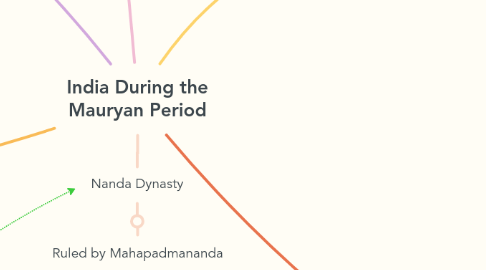
1. Administrative system during the mauryan empire
1.1. Key features of of the administration
1.1.1. Strong Central Authority:
1.1.1.1. He was advised by a Mantri Parishad (Council of Ministers), which included wise and experienced ministers. A smaller committee called Mantrana handled daily governance.
1.1.1.2. A smaller committee called Mantrana handled daily governance.
1.1.1.3. The king, Chandragupta Maurya, was both a ruler and an efficient administrator.
1.1.2. Decentralized System:
1.1.2.1. The empire was divided into different administrative units for efficient management.
1.1.2.2. Local people had autonomy in internal matters, ensuring smooth governance.
1.1.3. Government Officials
1.1.3.1. High-ranking officers, called Amatyas, were appointed to manage different departments. there are total 18 of them
1.1.3.1.1. The Amatyas
1.1.4. Administrative departments
1.1.4.1. Kautilya’s Arthashastra mentions 30 different departments handling taxation, trade, defense, and law enforcement.
1.1.5. Hierarchy of Officials
1.1.5.1. The highest authority was the samrat [Emperor]
1.1.5.2. The lowest official was the Gramini [village head]
1.1.6. Features that made it efficient
1.1.6.1. Separation of civil and military administration for better governance.
1.1.6.2. Independent judicial system to maintain law and order.
1.1.6.3. Fixed salary system for government officials.
1.1.6.4. Strict control over trade to ensure economic stability.
1.1.6.5. Focus on the well-being of people, both materially and morally
2. The magadha empire
2.1. during the struggle of the 4 main mahajanapadas, it was the 1st one to rise up, becoming the 1st empire.
2.1.1. Mahapadma
2.1.1.1. Builts a Fort @ Girivraja [1st capital of magadha]
2.1.2. Bimbisara [maha's son]
2.1.2.1. Ascends the throne after father dies
2.1.2.1.1. Attacks Kingdom of Anga & Conquers it
2.1.2.1.2. Builds matramonial Relations w kosala, Lichchhavi, Videh
2.1.2.1.3. Builds a New Capital 'Rajgriha' @ foot of fort
2.1.3. Ajatashatru [bimbi's son]
2.1.3.1. Kills his father
2.1.3.1.1. Expands magadha to vindhya ranges
2.1.3.1.2. builds a fort on the banks of ganga named 'pataliputra'
2.1.3.1.3. Deposed by the people; appoints shishunaga as the new king [his minister]
3. The Mauryan Empire
3.1. The 1st well organized and strongly controlled empire, spread on a large region of india and controlled by the central power
3.1.1. Ruled by Chandragupta Maurya
3.1.1.1. Conquers big & small states in the north, northwest and southern regions, creating a huge empire
3.1.1.2. The greek war w seleucus brought consequences
3.1.1.2.1. Boundaries of mauryan empire extended to the hindkush in northwest to bay of bengal in the east & gujurat in the west & himalayas in the north & krishna river in the south
3.1.1.3. Dies in 298 BCE
3.1.1.3.1. Bindusara becomes the king [son]
3.1.2. Emperor Ashoka
3.1.2.1. Coronated himself in 268 BCE
3.1.2.2. Calls himself 'Devanampiyo Piyadasi'
3.1.2.3. Early Period of his rule
3.1.2.3.1. adopts the expansionist policy 'digvijaya' of his ancestors
3.1.2.3.2. The kalinga war
3.1.2.3.3. Ashoka's career in dharmavijay
3.1.2.4. Decline of the mauryan empire
3.1.2.4.1. successors of ashoka were not as efficient leading to its decline
4. Nanda Dynasty
4.1. Ruled by Mahapadmananda
4.1.1. The 1st great Emperor, nanda
4.1.1.1. Builts canals & makes arrangements for irrigation facilities
4.1.2. The last great ruler, Dhanananda
4.1.2.1. During his period, State treasury and the military was enormousely huge
4.1.2.1.1. importance given to revenue collection stregnthen the central power of the empire
